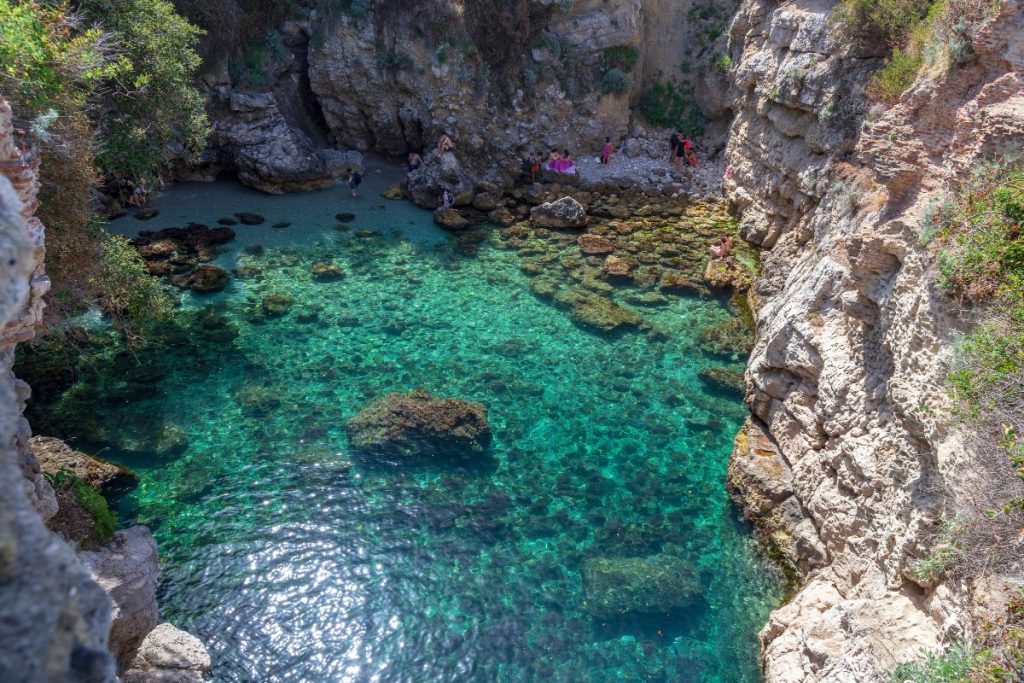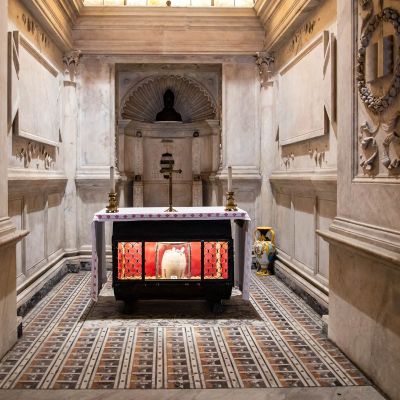Tucked away on the Sorrento Peninsula, the Bagni della Regina Giovanna offers a unique blend of natural beauty, historical intrigue, and mythical allure. This site, named after Queen Giovanna II of Naples who frequented it in the 15th century, is not just a stunning natural pool but also a place steeped in history and legend.
The Natural Pool and Its Setting
The Bagni della Regina Giovanna is a natural swimming pool enclosed by high cliffs and connected to the sea by a narrow channel. This secluded spot, shaped like a triangle and surrounded by lush vegetation, offers a tranquil escape from the bustling tourist areas. The pool is reachable by a scenic 30-minute walk from the center of Sorrento, leading through beautiful landscapes that heighten the anticipation of the destination.
Historical Significance
The site is not only renowned for its natural beauty but also for its historical significance. It is located near the remains of the Villa Pollio Felice, a grand Roman villa from the 1st century AD. This villa, once a luxurious retreat for the Roman elite, offers an insight into the opulent lifestyle of ancient Romans. The villa’s ruins include remains of rooms with barrel vaults and traces of stucco decorations, offering a glimpse into the past grandeur.
Archaeological Importance
The Bagni della Regina Giovanna is an important archaeological site, providing valuable insights into the Roman architecture and engineering. The villa was strategically built to enjoy views of Mount Vesuvius, Ischia, and Capri, and featured a portico with marble columns leading towards the sea. The intricate network of covered passages and staircases connecting the villa to the natural pool highlights the Roman’s sophisticated construction skills.
A Place of Myths and Legends
The site is shrouded in myths and legends, most notably associated with Queen Giovanna II. It is said that she used this secluded pool to meet her lovers, adding a layer of romantic and mysterious allure to the location. The combination of natural beauty and legendary tales makes the Bagni della Regina Giovanna a fascinating destination for visitors.

Experiencing the Beauty
Visitors to the Bagni della Regina Giovanna can enjoy swimming in the clear, calm waters of the pool or relax on the surrounding rocks. The serene environment is perfect for a peaceful day of sunbathing, picnicking, and immersing in nature. The absence of commercial establishments ensures the area retains its natural charm and tranquility.
Responsible Visiting
As the site is within an archaeological area, there are no facilities like restaurants or bars, so visitors should come prepared with food and water. It’s important to respect the site’s historical significance by disposing of waste properly and preserving the area’s natural and archaeological integrity.
Best Times to Visit
The best time to visit the Bagni della Regina Giovanna is in early summer, before the crowds arrive and when the temperatures are milder. For those seeking solitude, like Queen Giovanna, visiting at dawn or sunset offers a more intimate experience.
Tips for Travelers
For travelers planning to visit, it’s advisable to wear comfortable walking shoes for the hike and bring swimwear, sun protection, and a camera to capture the stunning views. The site is free to access, and while it is generally accessible for those with reduced mobility, the natural terrain may present some challenges.
Conclusion
The Bagni della Regina Giovanna in Sorrento is more than just a natural swimming spot; it’s a place where history, beauty, and legend intertwine to create a truly magical experience. Whether you’re a history enthusiast, nature lover, or simply seeking a unique spot to unwind, this natural paradise is a must-visit destination that captures the essence of the Sorrento Peninsula’s enchanting allure.
Discover More: “Discovering Sorrento: Things to Do in One Day“
After your visit to the Bagni della Regina Giovanna, continue exploring the wonders of Sorrento with “Discovering Sorrento: Things to Do in One Day.” This guide provides a curated selection of activities and attractions, perfect for experiencing the best of Sorrento in a limited timeframe. From historical sites to breathtaking views, our guide ensures that your visit to Sorrento is filled with unforgettable experiences. Explore “Discovering Sorrento” to plan your perfect day in this captivating Italian town.





